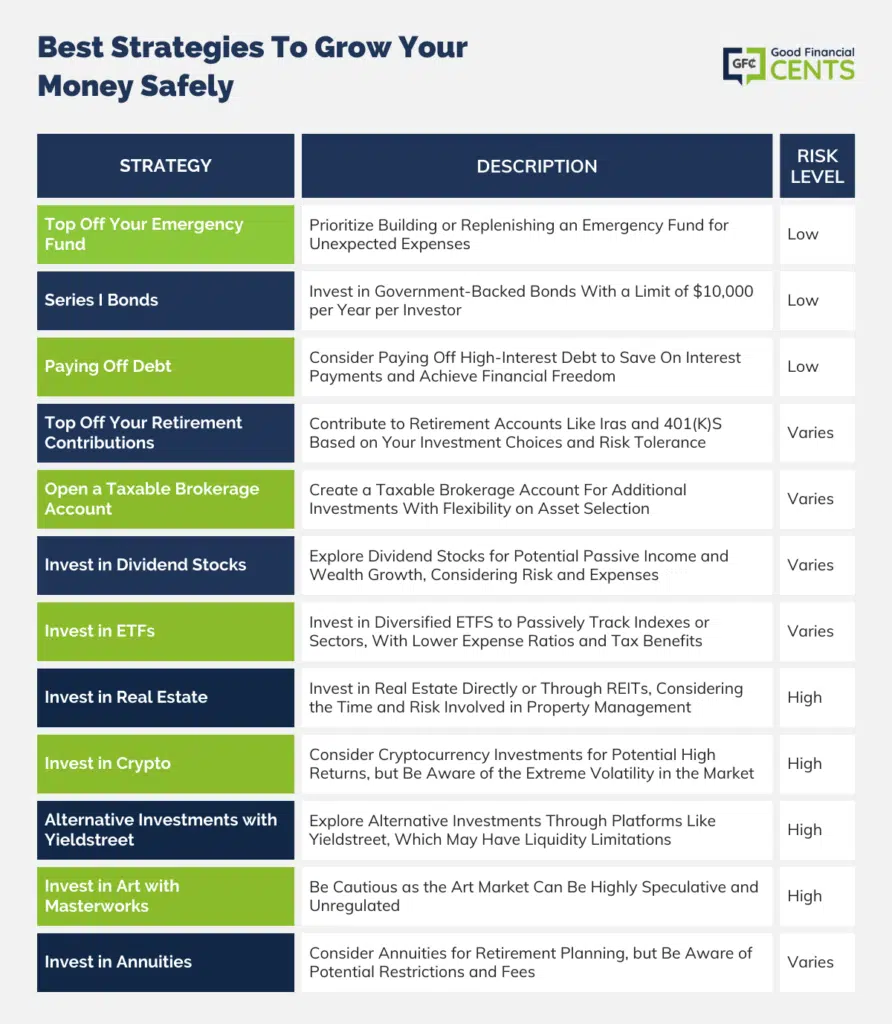When you think of the best ways to grow wealth for the long haul, the stock market might come up as a popular way to invest your money.
This makes total sense when you consider the fact more than half of American households (61%) have investments in the stock market to some degree, according to the latest Gallup Poll.
But if you’ve amassed $50,000 toward your next investment, the stock market isn’t your only option. Depending on your risk tolerance and investing preferences, some types of investments might be a better fit for you than others.
Here are some of the best uses for your money if you have $50,000 to invest.
Best Strategies to Invest $50,000 Starting Today
Table of Contents
- Best Strategies to Invest $50,000 Starting Today
- 1. Top Off Your Emergency Fund
- 2. Series I Bonds
- 3. Paying Off Debt
- 4. Top Off Your Retirement Contributions
- 5. Open a Taxable Brokerage Account
- 6. Invest in Dividend Stocks
- 7. Invest in ETFs
- 8. Invest in Real Estate
- 9. Invest in Crypto
- 10. Consider Alternative Investments With Yieldstreet
- 11. Invest in Art With Masterworks
- 12. Invest in Annuities
- Your Investment Style
- Conclusion – Best Ways to Invest $50,000
Technically speaking, an “investment” is something that gives you money back in return. We’ll include some of those on the list, but we’ll start with other “investments” that are equally important for your long-term financial and emotional health.
1. Top Off Your Emergency Fund
Risk Level:
If you don’t have a fully funded emergency fund, this should be your top investment priority. After all, it’s crucial to have extra cash you can tap into when you need it most.
Unfortunately, far too many people do not have any extra money to cover an unexpected car repair bill or other surprise expenses. According to a recent Bankrate survey of more than 1,000 adults, just about four in 10 adults (48%) have enough cash to cover a $1,000 emergency that pops up.
A good place to keep your emergency fund is in a high-yield savings account — a savings deposit account lets you easily access that cash.
It’s also recommended to keep some of it in cold, hard cash — say, $500 or $1,000 — in case of an emergency that shuts down the electrical grid (and ATMs with it).
The only downside to this approach is that, at least for now, savings accounts aren’t paying much interest at all. This is despite the fact the Federal Reserve has raised interest rates several times in recent years.
Nevertheless, having an emergency fund in some form is non-negotiable if you want to become financially stable. We recommend you check out CIT Bank for your online savings needs, yet there are plenty of other institutions to consider as well.

5.26%
Interest Rate
varies
Min. Initial Deposit
2. Series I Bonds
Risk Level:
Series I Savings Bonds (also called I Bonds) offer another low-risk way to invest any extra money you have, although you won’t be able to invest a full $50,000 within a given year.
This government-backed bond option has a maximum annual limit of $10,000 per investor, so you and your spouse or partner could invest up to $20,000 per year.
Interest rates on I-Bonds are set by the government, and they fluctuate based on inflation and other market conditions. The current rate for I-Bonds is 9.62%, which is a lot more than you’ll earn in a savings account.
Interest is compounded semi-annually, and you won’t even owe state or local income taxes on the gains you invest.
On the other hand, it’s important to understand how Series I Savings Bonds work before you dive in. For starters, you need to be able to avoid cashing out your I-Bond for at least 12 months. Also, be aware that if you cash in your I-Bond within five years, you’ll forfeit three months of interest.
3. Paying Off Debt
Risk Level:
In 2023, the average American carried $21,800 worth of debt (excluding mortgage), according to a Northwestern Mutual 2023 Planning & Progress Study.
If you’re carrying any debt — especially credit card debt or other high-interest debt — it makes sense to consider paying it off first before dropping money in the stock market.
Paying off your debt won’t exactly earn you money like an investment, but it lets you keep more of your dollars in your wallet for the future.
Not only that, but you’ll get a return on your money as you reduce the amount of interest you pay on your debts. If you use a debt payoff calculator, you can even find out how much you’ll “make” by paying off your debt today.
For many people, paying off debt offers more mental health benefits than financial benefits. There’s something very freeing about reducing your obligations to someone else, at least in a financial sense.
If you run into financial trouble in the future, it’ll be easier to skate your way through since you’ll have fewer bills.
4. Top Off Your Retirement Contributions
Risk Level:
Americans aren’t saving enough for retirement, and this was true even before the pandemic started wreaking havoc on the economy.
In fact, a Northwestern Mutual survey from 2021 found that 58% of Americans are still in recovery mode from the pandemic, with only 14% saving for expenses more than five years away.
In the meantime, 24% of Americans are still living paycheck-to-paycheck with no significant savings or plan to save for the long-term or retirement.
Obviously, this is a huge mistake! Unless you plan on going out early in a blaze of glory, chances are you’ll retire someday — by force or by choice — and you’ll need money to sustain you.
In 2025, you can contribute up to the following amounts in the different types of common retirement accounts:
- Roth IRA and Traditional IRA: $7,000 ($8,000 if you’re 50 or older)
- SEP IRA: 25% of your business compensation, or $69,000 (whichever is less)
- Solo 401(k): 100% of your business compensation, or $23,000 (whichever is less), plus employer contributions of 25% of total compensation up to a maximum of $69,000 in 2025
How risky or safe depends on what types of investments you choose for your account. You could invest in CDs, for example, for an ultra-safe (but low-earning) investment, or you could “bet it all at the racetrack” for a super-risky (but potentially high-earning) stock market reward.
Similarly, you have a lot of options when it comes to where to open your retirement account. If you have a workplace account like a 401(k), you’ll likely use your paychecks to fund it and go with whatever your employer offers.
However, you can put your $50,000 into an IRA or a retirement account for self-employed people if you’re a business owner or a side hustler.
5. Open a Taxable Brokerage Account
Risk Level:
A taxable brokerage account works just like an IRA, except you don’t get all the extra tax savings. On the flip side, you can take out that money anytime you want, provided you’re willing and able to pay short-term or long-term capital gains on any earnings you withdraw.
Just like with an IRA, you can choose to invest your $50,000 in money market accounts, stocks, bonds, index funds, mutual funds, ETFs, and more.
By and large, a taxable brokerage account gives you another place to invest in the market besides your retirement accounts.
If your emergency fund is already set up, you’ve maxed out your retirement contributions, and you still have extra money left over, a taxable brokerage account can help grow your $50,000 over the long term.
Since this money won’t be in a tax-advantaged retirement account, you can also use your taxable brokerage account to fund an early retirement if you can afford it.
Want to find the best place to open a brokerage account? Check out my picks for the best online brokerage accounts for beginners to experienced investors.
6. Invest in Dividend Stocks
Risk Level:
Dividend stocks are a type of investment that pays out dividends over time. Investors who choose dividend stocks can choose to use their dividends as a form of passive income, but they can also reinvest their dividends to continue building wealth at a much faster rate.
Believe it or not, it’s more than possible to make $1 per month in dividends or more with the right strategy.
Note that dividend stocks are typically offered by companies that have a long history of strong profits, so they are typically seen as less risky than other types of investments.
However, dividends aren’t necessarily guaranteed, and expense ratios for dividend stocks, mutual funds, and ETFs can be higher than investment options without dividends.
Like other ways to invest in the stock market, you can invest in dividend stocks by opening an online brokerage account. Some of the best platforms for this type of investment include Robinhood and M1 Finance since both options let you invest without any trading fees.
7. Invest in ETFs
Risk Level:
Exchange-traded funds (ETFs) are created using a portfolio of stocks, bonds, and other securities that are built to match an index.
While there is an array of ETFs to choose from, you can typically select from ETFs that invest in broad markets (like the S&P 500) or in specific sectors like energy or healthcare. You can also find ETFs that are invested in commodities, such as gold or oil.
This type of investment has become popular over the last few decades, and it’s easy to see why. Not only do ETFs come with low expense ratios, but they can be easily bought and sold like stocks.
Since ETFs are made up of a basket of stocks, bonds, and other securities, they also make it easy to invest passively and for the long haul.
ETFs can also come with tax benefits since they don’t trade component stocks often, so they don’t generate taxable capital gains the way mutual funds do.
The best part? Investing in ETFs is easy with the best online brokerage accounts, and some even let you get started with no minimum balance requirements.
If you’re looking for the best place to get started with ETFs, check out Betterment. This app makes it easy to buy a portfolio of diversified ETFs, and you even get help planning for retirement and other financial goals.
8. Invest in Real Estate
Risk Level:
The last few years of real estate gains have created massive wealth for existing homeowners and investors.
In fact, the National Association of Realtors (NAR) reports that the median home value for all types of housing was up 19.1% from the year before as of August 2023.
This specific period of increase also marks “119 consecutive months of year-over-year increases, the longest-running streak on record,” they write.
Real estate is also a broad investment category since it can include commercial or residential property, and $50,000 might not buy you an entire rental property unless you live somewhere with a very low cost of living.
However, you can use it as a down payment for your own rental property if you want to be a landlord. That said, this is one of the riskier and more time-consuming ways to invest in real estate.
You can also invest in real estate indirectly through REITs (real estate investment trusts) that work a lot like index funds.
With REITs like RealtyMogul, you still get the potential for big rewards, but you don’t have to worry about fixing a broken toilet in the middle of the night (or paying for a property manager to do it for you).
If you want to invest in real estate with as little hands-on work as possible, you can also look into a company called Fundrise. This company lets you invest in real estate with a minimum investment of $10, and you don’t even have to be an accredited investor to get started.
While returns are relatively low with Fundrise so far in 2022, the company reported an average return of 1.50% for its investors in 2022.
| I’ve been investing with Fundrise since 2018. Disclosure: when you sign up with my link, I earn a commission. All opinions are my own. |
9. Invest in Crypto
Risk Level:
While cryptocurrency is incredibly volatile, it’s possible to make money with crypto in several different ways. The first one involves investing in crypto with a platform like BlockFi at the right time so your digital assets grow and increase in value.
At that point, you can sell your crypto for profit, or you can keep on HODLing (holding on for dear life) to see if your crypto increases in value even more over time.
You can also earn money with crypto with the help of a crypto savings account. As an example, a crypto savings account from Celsius pays up to 18.63% weekly on your crypto deposits, and you still get to keep your crypto on deposit so it can grow in value over time.
If you want to get started in crypto, you’ll need to do some basic research on how various coins work and all the pitfalls to be aware of.
You’ll also need to compare the best crypto exchanges to see which ones let you invest in the crypto you’re interested in, as well as how they stack up in terms of functionality and fees.
Just remember that crypto investors can lose money just as quickly as they earn it. After all, a single Bitcoin was worth over $27,115.85 near the end of September 2023.
10. Consider Alternative Investments With Yieldstreet
Risk Level:
If you’re looking for yet another way to invest $50,000 or at least part of that amount, you can also look into investing in alternative platforms such as Yieldstreet.
This platform says they “provide access to alternative investments previously reserved only for institutions and the ultra-wealthy,” and they report an average net annualized return of 9.71% since their inception in 2014.
While you’ll have to do some digging to learn how Yieldstreet works — and where your money actually goes — a quick look on the company website shows that they offer myriad offerings and funds to choose from.
For example, the YieldStreet Prism Fund is a fixed-income portfolio spread across myriad asset classes from art to commercial property, real estate, and more. The minimum investment is just $500, and this fund is always open to new investment.
From there, investors can choose from other funds that focus on themes, including crypto funds, art funds, and even REITs.
With all this being said, many investments offered through YieldStreet are only available to accredited investors.
Not only that, but these funds are highly illiquid, meaning you can’t just withdraw your investment any time you want. In fact, you may have to wait months or even years to get your money out.
That makes YieldStreet a good potential option for long-term growth but a poor one if you’re looking for a place to park your emergency fund.
11. Invest in Art With Masterworks
Risk Level:
If you absolutely love art and wish you could invest in it, a company like Masterworks can help you do exactly that. Masterworks reports an average return of 14.3% for their investors so far, net of fees.
This company also claims to have helped more than 400,000 individual investors build up a portfolio of art investments that pay off over time.
With this being said, investing with Masterworks will be inherently risky for more reasons than one. First, art, in general, is only worth what someone will pay for it, so there’s no way to guess what your returns could be in any given year.
Not only that, but the art world is highly unregulated, and Masterworks itself has only been in operation since 2017.
The good news about Masterworks is the fact that investments start at just $500 and that investors can spread their money across multiple pieces of art in increments of $20.
On the flip side, you may not have a true understanding of what you’re investing in unless you’re incredibly knowledgeable in the world of art. Even then, this investment class is risky, and Masterworks is still in its infancy as a company.
12. Invest in Annuities
Risk Level:
Finally, you can always consider the prospect of investing $50,000 into an annuity. That said, you’ll need to do a ton of research to understand how annuities work, and you’ll need to make sure you don’t actually need this money until years or decades from now.
The first thing to understand is that, at their core, annuities are a type of investment geared toward retirement. In fact, withdrawing money from an annuity can result in penalties before age 59 ½, including a 10% penalty from the Internal Revenue Service (IRS).
How annuities work depends on the type of annuity you plan to invest in. Some of the safer annuities include fixed annuities, single premium immediate annuities, deferred income annuities, and fixed indexed annuities.
There are also variable annuities that are overly complex and charge high fees.
Are annuities a good investment? That really depends on what your goals are, when you’ll need the money, and which other investments you’re taking advantage of first.
At the end of the day, annuities can make sense in a variety of situations, but you should conduct due diligence and understand any and all fees you’re paying, as well as early withdrawal penalties and surrender charges that can apply.

Your Investment Style
After the basics, like topping off your emergency fund and paying off debt, investing a sizable $50,000 can put you on the path toward long-term wealth and financial freedom.
Even so, investing such a large sum of money isn’t always easy, and your options aren’t necessarily cut and dry.
For example, if you want to save money in a retirement account or open a taxable brokerage account, you’ll need to know what type of investments to put in there and how and when to adjust them over time.
That’s the tricky part for a lot of people. Deciding on how you want to handle this — or not — in advance can help you plan your strategy.
DIY Investor
If you’re comfortable with learning the ins and outs of investment strategies and doing all of the management yourself, opening a brokerage account can be the best way to go for investors of all experience levels.
That’s because you’ll save the most amount of money in management fees, which can be a big drain on your earnings. But on the flip side, if you make unwise or uninformed choices, you could lose a lot, too.
Robo-Advisor
Robo-advisors are a great option for people who can’t or don’t want to work with a live human and who also aren’t interested in a completely hands-off approach.
They take you through a questionnaire to figure out what your financial goals are, and then they choose and manage your investments for you according to an algorithm.
This is usually a lot cheaper than hiring an investing professional to do it for you, and it removes tricky (and costly) emotions from the equation, too.
Once you start researching robo-advisors, you’ll quickly find that there are a ton of reputable companies to choose from as well. The best robo-advisors are ones you have probably heard of, such as Betterment, Personal Capital, and M1 Finance.
My guide to the best robo-advisors of 2023 can help you pick the right company for your needs, your goals, and the way you want to invest.
Hire a Financial Advisor
Financial advisors can perform many different roles in your financial life, from long-term retirement planning to helping you plan for short-term goals.
If you really couldn’t care less about how your investments are managed, hiring a financial advisor might be your best choice. They are available to manage your investments and answer your questions throughout the entire process — of course, this is usually the highest-cost option.
Conclusion – Best Ways to Invest $50,000
If you’re in the enviable position of having $50,000 to invest, a variety of the options listed above could help you reach your goals. Fortunately, you don’t need to choose one option at the expense of all of the others.
You can choose bits and pieces from this list and spread your $50,000 investment in whatever way you want.
Whatever you do, don’t sit on $50,000 in cash for too long. The sooner you invest your hard-earned cash, the faster your money can grow.








I’m 40 how much 50k will do in 5 year doing it aggressive but low risk I don’t know if that is possible
If I’m 62 what would my portfolio look like for 50,000?
Hi Judith – Without knowing you or your personal financial situation I can’t make specific recommendations. But you might want to talk with a financial advisor, or even sign up with a robo-advisor. They’ll create a portfolio for you based on your investor profile. Betterment and Wealthfront are two of the best robos.